An ethnobotanical study of medicinal plants in Güce district,north-eastern Turkey
Mustafa Karako¨se
Giresun University, Espiye Vocational School, Programme of Medicinal and Aromatic Plants, Espiye, Giresun, 28600, Turkey
Keywords:Colchic Ethnobotany Informant consensus factor Frequency of citation Traditional medicine Use-record
A B S T R A C T This study aims to identify medicinal plants traditionally used to treat diseases by local people living in Güce district, north-eastern Turkey. The study was carried out between 2018 and 2021 using a two-part semi-structured,open-ended questionnaire with 165 local people. Data were analysed using use-report,frequency of citation,and informant consensus factor.Informants identified 128 vascular medicinal plant taxa belonging to 54 families and 106 genera.The most common plant taxa belong to Rosaceae(16 taxa/12.5%), Asteraceae (12 taxa/9.4%), and Lamiaceae (9 taxa/7%) families. The most frequently used preparation method reported was decoction (39.8%); the most commonly utilized plant parts were leaves(40.3%). Statistical analysis reveals that women in Güce district (df = 163, p = 0.043 < 0.05) possess the most traditional knowledge.The highest frequency of citation(61)and use report(92)were recorded for Tilia rubra subsp. caucasica, and the highest informant consensus factors were cited for respiratory system disorders (0.86), digestive system disorders(0.73),and skin disorders(0.71).This study reported nine plant taxa as medicinal plants for the first time, and documented a total of 293 new therapeutic uses. However, the study indicates that the transfer of traditional knowledge to future generations is limited(F=3.355,p=0.020).Action should be taken as soon as possible to preserve existing traditional knowledge and to ensure its transfer to future generations.
1. Introduction
Of the 17 sustainable development goals adopted by the Member States at the United Nations General Assembly in September 2015 at least seven are related to traditional knowledge (TK)(Kumar et al.,2021),the product and whole of the interaction of the individual and society with nature (Berkes,1993). However, TK is being lost throughout the world (Ramirez, 2007). Thus, documentation of TK is important to safeguard the rights of local people during an era of globalization (see Article 8 of the Convention on Biological Diversity (CBD) and strategic goal E of Nagoya Protocol;Ghimire et al., 2018). TK, which has a close relationship with biodiversity (Idolo et al., 2010; Aswani et al., 2018), also has the potential to contribute to scientific knowledge for the conservation and sustainable use of biodiversity, and thus, ecosystems (Gaoue et al., 2017). Accordingly, preserving TK of natural flora has become a central focus of ethnobotany (Berkes et al.,1995, 2000;Mustafa et al.,2012; Dalar et al.,2018;S~oukand and Pieroni,2019;Hu et al., 2020; Mattalia et al., 2021). Ethnobotanists have documented the use of plants in customs/traditions, folk nutrition, folk cuisine,and folk medicine in different parts of the world(¨Ozdemir,2018;Karak¨ose et al.,2019;Pei et al.,2020).These studies both help conserve TK and expedite the discovery of new drugs, as natural plant biodiversity in many regions provides rapid, cheap, and sufficient alternative resources for healthcare of local people(Kathambi et al., 2020). Importantly, protecting TK of plants (e.g.,medicinal plant use) requires identification of both plant taxa and an understanding of which members of a community possess TK(Mathur,2003).TK is abundant in Turkey,a region that has hosted many civilizations that have left their cultural,social,and ecological richness as a heritage(Y?ld?r?ml?,2004;Kendir and Güven?,2010).Turkey is located at the intersection of three phytogeographical regions (Circumboreal, Mediterranean, and Irano-Turanian) and three of the world's 36 biodiversity hotspots(Mediterranean Basin,Irano-Anatolian, and Caucasus biodiversity hotspots) (Myers et al.,2000;Mittermeier et al.,2004).It has complex topography,climate,and soil differences. Consequently, Turkey has approximately 12,975 plant taxa and nearly 4175 endemic plants (with an endemism rate of 32%)(Davis,1965-1985;Davis et al.,1988;Güner et al.,2000,2012; ¨Ozhatay et al.,2019;Karak¨ose,2020).In addition to this biodiversity, Turkey has a high degree of TK related to medicinal plant use (Karak¨ose and Terzio?glu, 2019, 2020). However,modernization in Turkey is gradually displacing TK(K?z?larslan and¨Ozhatay, 2012).
Although ethnobotanical studies have been conducted in Turkey since the beginning of the Republican period (Baytop,1999), their number has increased considerably in the last two decades(?ak?lc?o?glu et al., 2011; Polat and Sat?l, 2012; Polat et al., 2013;Sarg?n et al.,2013,2015;Tetik et al.,2013;Akbulut and ¨Ozkan,2014;Hayta et al., 2014; Güzel et al., 2015; Gunes, 2017; Akbulut et al.,2019; Karak¨ose et al., 2019; Sarg?n and Büyükcengiz, 2019;Kawarty et al., 2020). In 2017, the Biological Diversity of Department of the General Directorate of Nature Conservation and National Parks began a project on “Registration of Traditional Knowledge Associated with Biodiversity”, which will cover 81 provinces in Turkey, and create a “Traditional Knowledge Management System” available to researchers. Thus far, only a limited number of ethnobotanical studies have been carried out in the Giresun province (Polat et al., 2015; Güler et al., 2021).
Giresun is a mountainous and rugged region with habitats important for biodiversity. It harbors the Euxine-Colchic broadleaf and Caucasus mixed forests, which belong to the Caucasus biodiversity hotspot (Karak¨ose, 2019) and are classified as one of 200 Global Ecoregions (WWF and IUCN, 1994; Akbulut and Kurdo?glu,2015). Districts within this region (e.g., Güce district) have been affected by the increasing global demand for natural resources,which has fragmented and reduced natural habitats. Habitat and biodiversity loss threaten the ability of local people to maintain,use and transfer TK to future generations. Thus, it is critical to record and scientifically evaluate the high biological and socio-cultural richness of the TK in places such as Güce.
This study aims to identify medicinal plants traditionally used to treat diseases by local people living in the Güce district, northeastern Turkey. In addition, I determined whether TK of these plants differs depending on the gender,age,and education level of informants. This is the first ethnobotanical study carried out in Giresun's Güce district. The comprehensive quantitative, qualitative, and statistical evaluations of this study will contribute to the TK associated with biodiversity in Turkey.
2. Material and methods
2.1. Study area
Güce, one of Giresun's eastern districts, is surrounded by the Tirebolu district to the north, south, and east, and the Espiye district to the west (Fig. 1). “Güce” is a Turkish word meaning“broken wheat, split corn, vetch”. Some local studies have associated this word with the word“kü?e”,which means small(http://guce.gov.tr/tarihi). The settlement of the district began in 2000 BCE,before the conquest of the Muslim Turks. During the attacks before the Anatolian Seljuks, Turkish clans, including the Eymür,Hala?,Avs?ar,and Kipchaks,settled in the region.Turkish clans are known to have migrated to the Güce region from Asia. Güce, an intersection of important historical roads, is also one of the meeting centers of the region (Kaya, 2019). The conquest, settlement, and Islamization of the geography, including the Güce district(after the 10th century),was realized by the Chepni Turks,one of the 24 clans of the Oghuz Turks (http://www.guce.bel.tr/sayfa/tarihcemiz.html). Established on rough lands, Güce is a settlement unit connected to Tirebolu,which was the only town in the vicinity until the 20th century.The municipality organization was established in 1990 in Güce,which is a center connecting the surrounding villages(Kaya,2019).The local language in the region is Turkish. The district is located in the south, about 15 km from the coast, and between 40°-53°northern latitudes and 38°-48°eastern longitudes;the elevation of the district varies between 50 and 2650 m. In 2021, the population of Güce was 8098. This population consists of 4131 (51.01%) men and 3967 (48.99%)women (https://data.tuik.gov.tr/).
The local people of Güce mostly earn their living from agriculture, animal husbandry, beekeeping, and forestry. In terms of agriculture, local people primarily grow small-scale agricultural products such as corn,cabbage,and bean for their own needs.The wild cherry tree Prunus avium (L.) L. (Syn.: Cerasus avium (L.)Moench) originated in Giresun. For this reason, its former name“Kerasous or Cerasus” derives from the word cherry. Additional agricultural sources of income for the people of Güce include hazelnut and tea farming, which contribute greatly to the Turkish economy (Fig. 2a). Giresun's primary source of incomes are the Corylus spp.The highest quality hazelnuts in the world are grown in Giresun province. Livestock and dairy products such as butter,yoghurt, and cheese are produced, and honey production is very popular in the region.Some people also earn income from forestry activities (cutting, plantation, silviculture,etc.).
2.2. Vegetation structure
The forests in Güce district are managed by the Güce Forest Enterprise, which is administratively affiliated with the Tirebolu Forestry Management Directorate within the borders of the Giresun Regional Forestry Directorate.Güce is located in the Colchic sector of the Euxine province of the Circumboreal phytogeographical region, and falls within the A7 square according to the grid system(Davis,1965-1985). The annual mean temperature is 12.9°C, and the annual mean precipitation is 878 mm.Moreover,the study area is under the influence of the oceanic climate below elevations of 1500 m, and semi-continental climate is felt at higher vegetation zones. Due to abundant rainfall and suitable temperature in all seasons, the lands of the district are rich in forest vegetation. The study area covers an area of about 184 km2(68.8 km2of this area is forested).Forest ecosystems belonging to the Giresun province,and also to Güce district, are of enormous importance and distributed within the Caucasus Biodiversity Hotspot. The Mediterranean climate makes itself felt at low elevations. It is possible to see species such as Arbutus unedo L., A. andrachne L., Laurus nobilis L.,and Erica arborea L. in these areas. Forest vegetation consisting of deciduous species dominates at elevations up to 1000 m.Important species of this vegetation type include Tilia rubra DC. subsp. caucasica (Rupr.) V. Engl., Ulmus glabra Huds., Carpinus betulus L.,Quercus petraea (Matt.) Liebl. subsp. iberica (Steven ex M. Bieb.)Krassiln., Castanea sativa Mill., Alnus glutinosa (L.) Gaertn. subsp.barbata(C.A.Mey.)Yalt.,and Fagus orientalis Lipsky.At elevations of 1000-1750 (2000) m, coniferous forests consisting of Picea orientalis (L.) Peterm., Abies nordmanniana (Steven) Spach, and Pinus sylvestris L. var. hamata Steven (Fig. 2b) become dominant(Karak¨ose, 2019).
2.3. Data collection
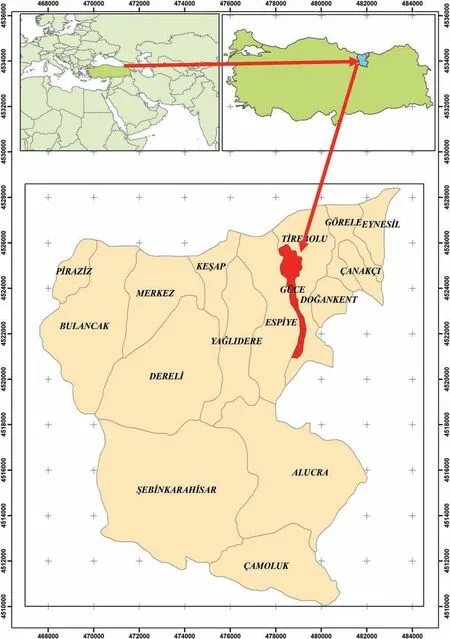
Fig.1. Location of the study area.
Ethnobotanical knowledge was recorded by means of semistructured interviews (Martin, 1995; Alexiades, 1996) with local people. Weckerle et al. (2018)'s recommendations were also considered within the scope of the study.Field studies were carried out in various vegetation periods between 2018 and 2021.Interviews were conducted with local people in person; a total of 165 informants were surveyed with a two-part questionnaire(Appendix A). The first part of the questionnaire aimed to determine demographic characteristics such as gender, age, and education level. The second part aimed to obtain information about medicinal plant taxa, including vernacular names, parts used,preparation-utilization methods, and ailments treated. In the first year of the field studies,my student Mehmet Ali(from the F?nd?kl? village) and I interviewed local people in the F?nd?kl? village to become familiar with the region(Fig.2i).Since Mehmet is from the F?nd?kl? village,informants in this village were easy to find.In other villages, informants were reached through headmen (known as“muhtar” in Turkish) with the help of the Güce Forest Directorate.However, we noted that female participants were quite shy about sharing some information, especially on gynecological diseases.Fortunately, these problems were mitigated when Forest Engineer G¨ozde ?olak Karak¨ose(my wife)joined the interviews(Fig.2c and d). Another problem was that older informants had difficulty remembering plant names during the interviews. In such cases, I used an illustrated brochure based on a floristic study carried out close to this study area(Karak¨ose,2019).One final obstacle during this study was the Covid-19 pandemic. The Covid-19 pandemic,which manifested itself in Turkey in 2020, required additional precautions during village visits.As mentioned before,since Güce's forests(12 villages are known as forest-dominated villages)belong to Tirebolu, coordination was made with the Tirebolu Forestry Management Directorate.In addition,Forest Engineer Mustafa S?en,the director of the directorate who is also from the ˙Ilit village of Güce, contributed to TK(Fig.2f). During the study,each informant was informed that the research was for academic purposes,not for commercial purposes, and their consent was obtained. This ensured that informants did not treat the study with suspicion. In addition, this study complied with the International Society of Ethnobiology Code of Ethics (with 2008 additions) (http://www.ethnobiology.net/what-we-do/core-programs/ise-ethics-program/code-of-ethics/).

Fig. 2. Photographs from the study area. a: hazelnut and tea plantations; b: Picea orientalis forest and tree line; c, d: G¨ozde ?olak Karakose is interviewing local people; e: plant presentation with illustrated brochure;f:forest engineer Mustafa S?en(Tirebolu Forestry Management Directorate);g:F?nd?kl? village;h:Day?c?k village;i:interview with Mehmet Ali and his father.
2.4. Plant materials and identification
Plant materials were collected from F?nd?kl?, Boncuk?ukur,Day?c?k, Düz?ukur, F?r?nl?, Güra?ga?, ˙Ilit, Sar?yar, Ergenekon,Tekkek¨oy, Yukar?boynuyo?gun, So?gukp?nar, ¨Ornekk¨oy, and Tevekli villages and from Giyimli-Kemaliye neighborhoods located in the center of Güce(Fig.2g and h).The location of the plant specimens collected during the surveys, the characteristics of the habitat,elevations, and collection dates were recorded. Plants were identified using the“Flora of Turkey and the East Aegean Islands”(Davis,1965-1985;Davis et al.,1988;Güner et al.,2000).Scientific names of plant taxa were checked using the Turkish Plant List(Güner et al.,2012) and updated according to World Flora Online (http://www.worldfloraonline.org/). Threat categories of plant taxa were determined according to Ekim et al.(2000)and the International Union for Conservation of Nature (IUCN) (https://www.iucnredlist.org/).The voucher specimens were kept in Giresun University Herbarium. Upper taxonomic units of plant taxa were arranged according to Christenhusz et al.(2011a)and Pteridosperm Phylogeny Group I(PPG I, 2016) for Pteridophyta, Christenhusz et al. (2011b) for the Gymnospermae sub-division, and Angiosperm Phylogeny Group(APG) IV (Chase et al., 2016) for the Angiospermae sub-division.
2.5. Data analysis
The ethnobotanical data collected in this study was presented as primary data following the recommendations of Heinrich et al.(2009), Weckerle et al. (2018), and Leonti (2022). Data were analysed quantitatively using use report (UR), frequency of citation(FC), and the informant consensus factor (ICF). MS Excel was used for data entry and summary; quantitative indices were then calculated based on presence/absence data using the ethnobotanyR(Whitney, 2021) package (R package v.0.1.8.). UR and FC are the most commonly used calculations for determining the accuracy of ethnobotanical data.UR gives information about a plant or a plant part used by one informant. FC is the number of informants who mentioned the use of a plant species. FC calculates the notional importance of each plant taxon without considering the ailment categories, while also showing their cultural significance (Tardío and Pardo-de-Santayana, 2008).
To calculate the homogeneity of knowledge gathered from interviewed local informants,the ICF formula developed by Trotter and Logan (1986) was used. The index was calculated by the following formula:

where Nur is the number of UR for each ailment category,and Nt is the number of plant taxon used. ICF value ranges from 0 to 1,where“1”indicates the highest level of informant agreement.Low values (towards zero) demonstrate disagreement among informants about the usage of the plant species for a specific ailment category (Heinrich et al., 1998). ICF values were created for 16 ailment categories arranged according to the International Classification of Primary Care (ICPC-2) (https://www.who.int/standards/classifications/other-classifications/internationalclassification-of-primary-care).
2.6. Statistics
The independent samples t-test (α = 0.05) was computed to compare the differences in the number of medicinal plant species and their associated TK reported by male and female informants.The change in plant knowledge according to age and education level was also analysed with ANOVA and post hoc (Tukey) using SPSS software (v.22).
3. Results and discussion
3.1. Demographic characteristics of the informants
Informants included the headmen of relevant villages, farmers,foresters, shepherds, villagers, housewives, and the other local people. The majority of informants were male (99; 60%), although 40%(66)were female.The age of the informants ranged from 21 to 97, with a mean age of 56.7. More detailed demographic information on the informants is given in Table 1.
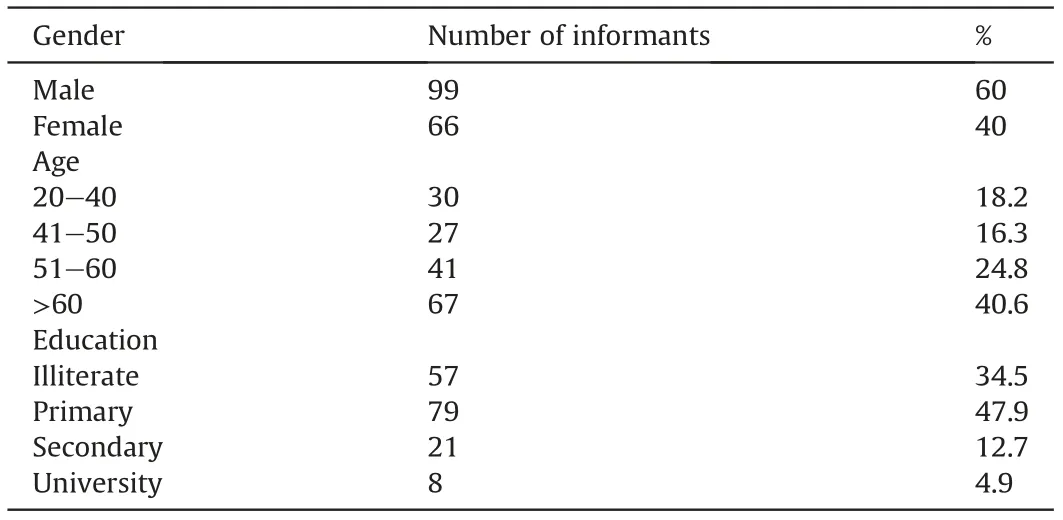
Table 1 Demographic characteristics of the informants in the study area.
3.2. Plant taxonomy and associated knowledge
This ethnobotanical study identified 128 vascular medicinal plant taxa belonging to 54 families and 106 genera in Pteridophyta and Magnoliophyta(Pinidae and Magnoliidae subclasses)sections.The medicinal plants used in Güce district are listed in Table 2,which also contains information on plant vernacular names, parts used,preparation and utilization methods,therapeutic effects,URs,and FCs.Some medicinal plants are given in Fig.3.The Pteridophyta section (Equisetidae and Polypodiidae sub-classes) is represented by four (3.1%) taxa within the Polypodiopsida class. The Gymnospermae(order of Pinales within the Pinidae sub-class)sub-section is represented by two families, four genera, and four woody taxa(3.1%). The Angiospermae (Mesangiospermae) sub-section is represented by 124 (96.9%) species and sub-species. Monocot angiosperms are represented by 12(9.4%)plant taxa,whereas dicots are represented by 112 (87.5%) taxa.
The number of medicinal plant taxa collected in Güce district was higher than that found in previous studies(except for Kazanc? et al.,2020) in other parts of the north-eastern Black Sea region (Fujita et al.,1995; Türkan et al., 2006; Sa?g?ro?glu et al., 2012; Sara? et al.,2013; Akbulut and ¨Ozkan, 2014; Polat et al., 2015; Emina?gao?glu et al., 2017; Karak¨ose et al., 2019; Bak and ?if?i, 2020; Gürdal and¨Oztürk, 2021). Only Kazanc? et al. (2020), in their study of the plants of two neighboring countries, catalogued more plant taxa than this study.High medicinal plant diversity emerges as a result of local people living in touch with nature(Khajuria et al.,2021).
Among the identified taxa, herbs are represented by 73 (57%)taxa,trees by 28(21.9%)taxa,shrubs by 16(12.5%)taxa,climbers by ten (7.8%) (including six woody), and one vascular semi-parasite(0.8%) plant. The distribution of plant taxa according to phytogeographical regions is as follows: Circumboreal 46 (35.9%) taxa,Mediterranean 5(4%),and Irano-Turanian 2(1.6%).Of the recorded medicinal plants, 28 (22%) taxa were cultivated. The remaining 47 taxa (36.7%) were cosmopolitan and pluri-regional. Circumboreal plant taxa predominate the research area, as the study area is within the Euxine province of the Circumboreal phytogeographical region (Karak¨ose, 2019). Families with the richest medicinal plant diversity were Rosaceae(16 taxa/12.5%),Asteraceae(12 taxa/9.4%),Lamiaceae(9 taxa/7%),followed by Apiaceae and Ericaceae(each 5 taxa/4%), Amaranthaceae (4 taxa/3.1%), Amaryllidaceae, Brassicaceae, Fagaceae, Malvaceae, Moraceae, Pinaceae, Polygonaceae, and Solanaceae (each 3 taxa/2.3%). An additional 53 medicinal plant taxa belong to the remaining 40 families (Fig. 4). The ranking of families to which medicinal taxa belong in the Güce district is nearly identical to the ranking of families in the Flora of Turkey(Davis,1965-1985).Previous studies of the eastern Black Sea region reported similar results for the first two families(Fujita et al.,1995;Türkan et al.,2006;Sa?g?ro?glu et al.,2012;Karak¨ose et al.,2019;Bak and ?if?i, 2020), but ranked differently(Sara? et al.,2013; Akbulut and ¨Ozkan,2014;Polat et al.,2015;Emina?gao?glu et al.,2017;Karc? et al.,2017;Yes?ilyurt et al.,2017;Gürbüz et al.,2019;Kazanc? et al.,2020; Gürdal and ¨Oztürk, 2021).
Of the 128 medicinal plants used for ethnobotanical purposes,only three plant taxa(Helleborus orientalis Lam.,Veratrum album L.,and Pteridium aquilinum (L.) Kuhn) are used for ethnoveterinary purposes.
According to the data obtained in the study,medicinal plants are mostly used as mono-plants in Güce.Only three formulations have bi-plant uses. Hypericum androsaemum L. leaf and young A. glutinosa subsp. barbata leaves are combined and used as a hemostatic. A decoction of Trifolium pratense L. and Alchemilla caucasica Buser flowers is used for the common cold and influenza. A decoction of the Urtica dioica L.is applied in combination with flour of Zea mays L. to reduce swelling in sprains.
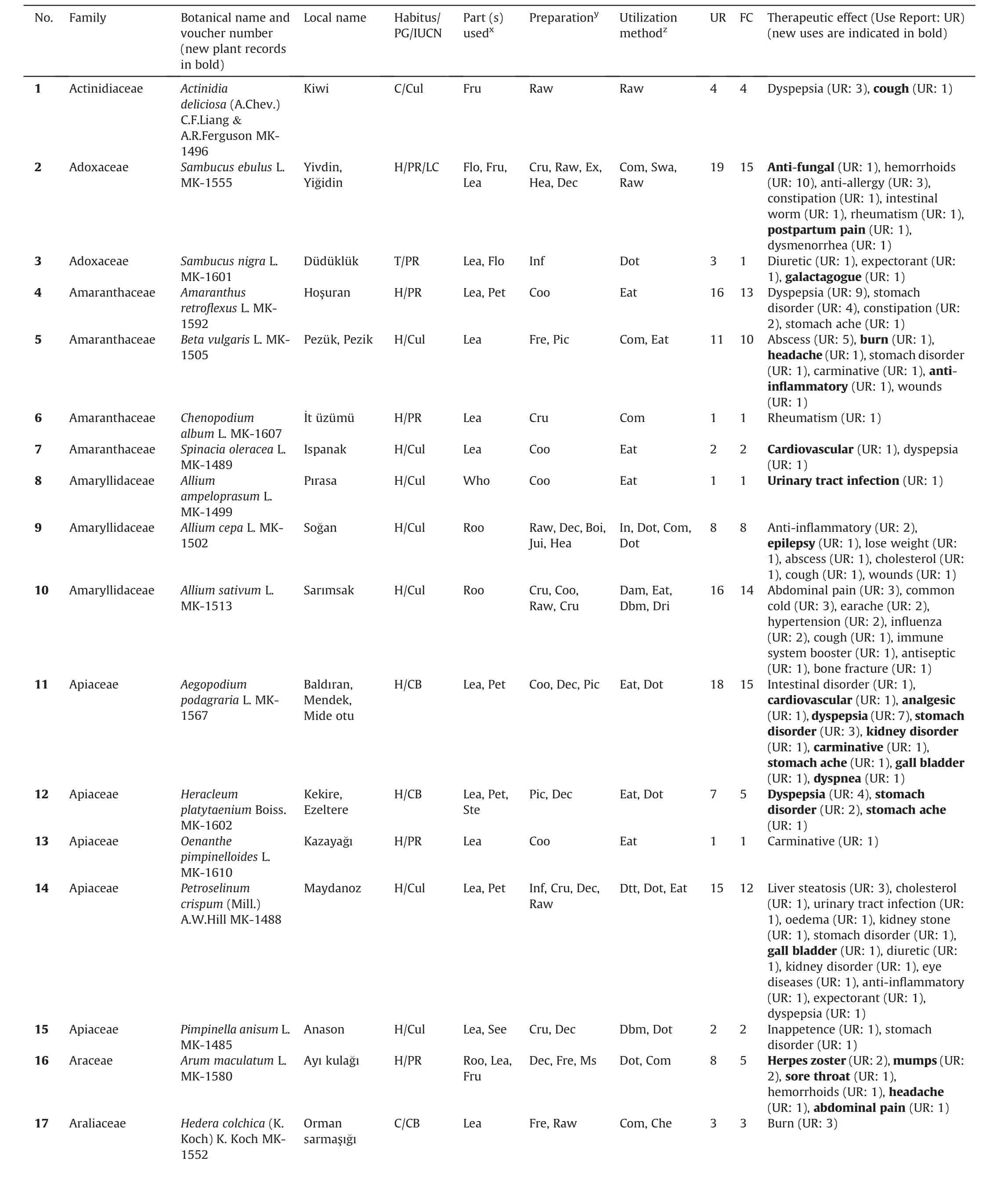
Table 2 The medicinal plant taxa from Güce district, with its related knowledge.
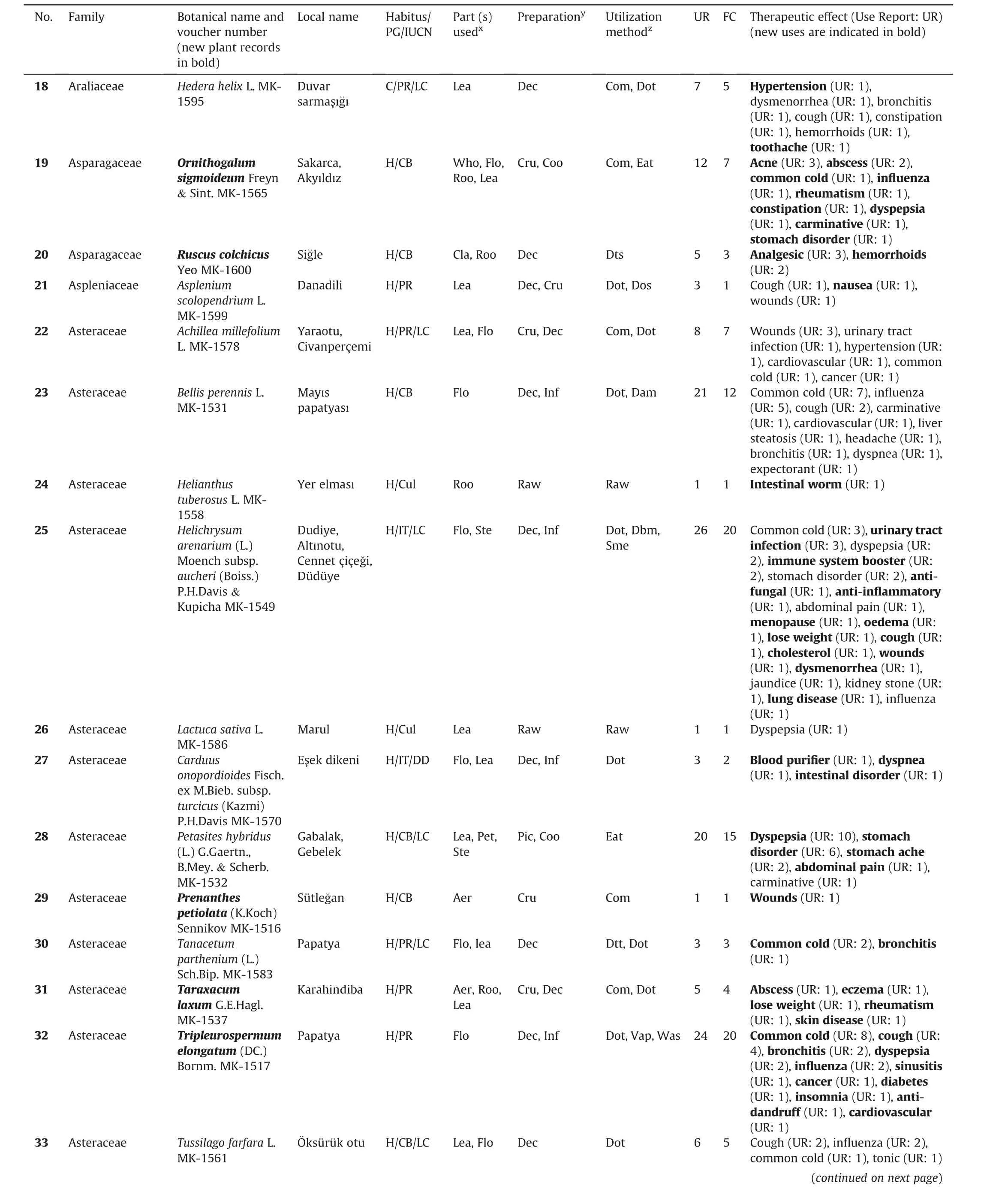
Table 2 (continued)
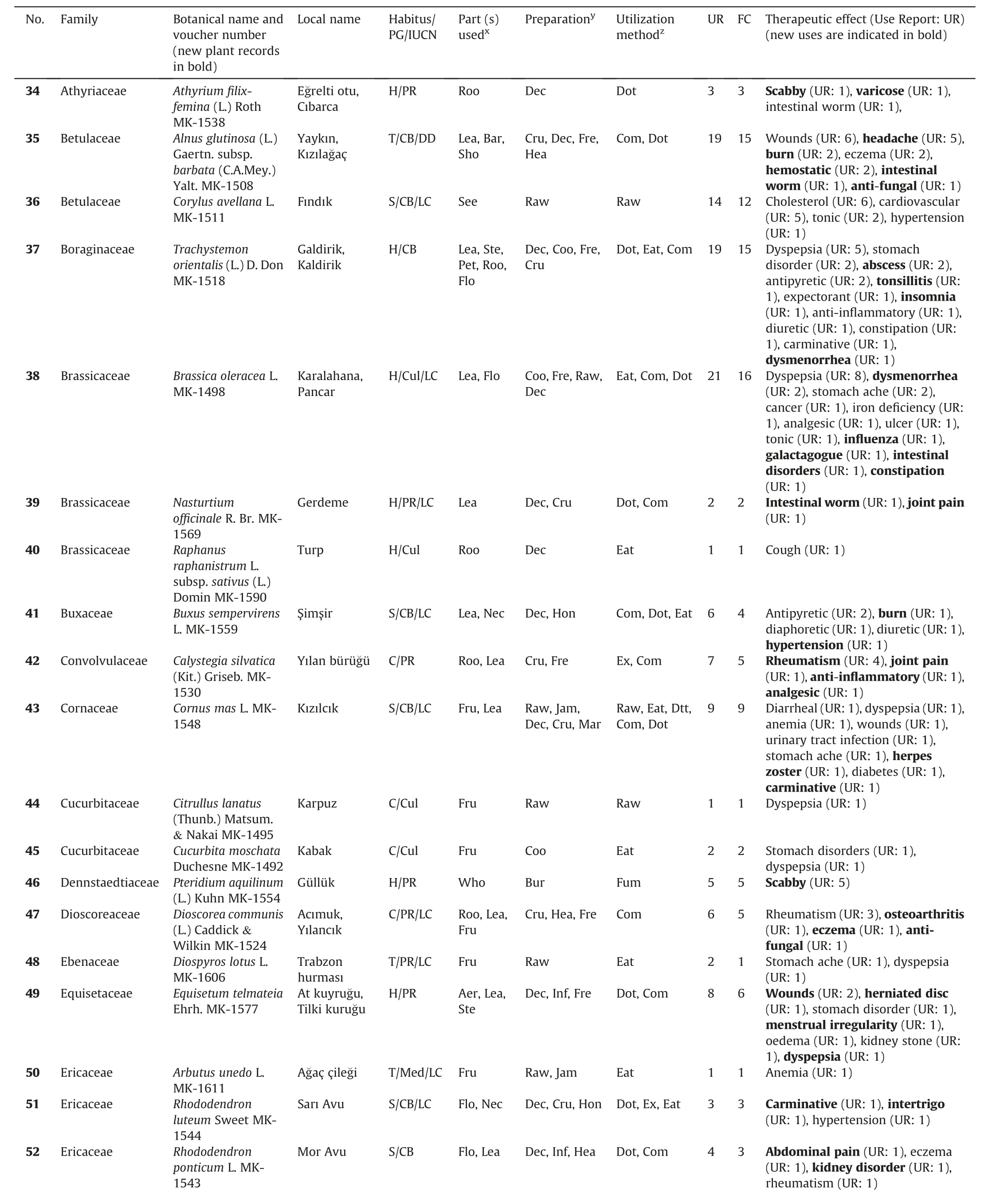
Table 2 (continued)
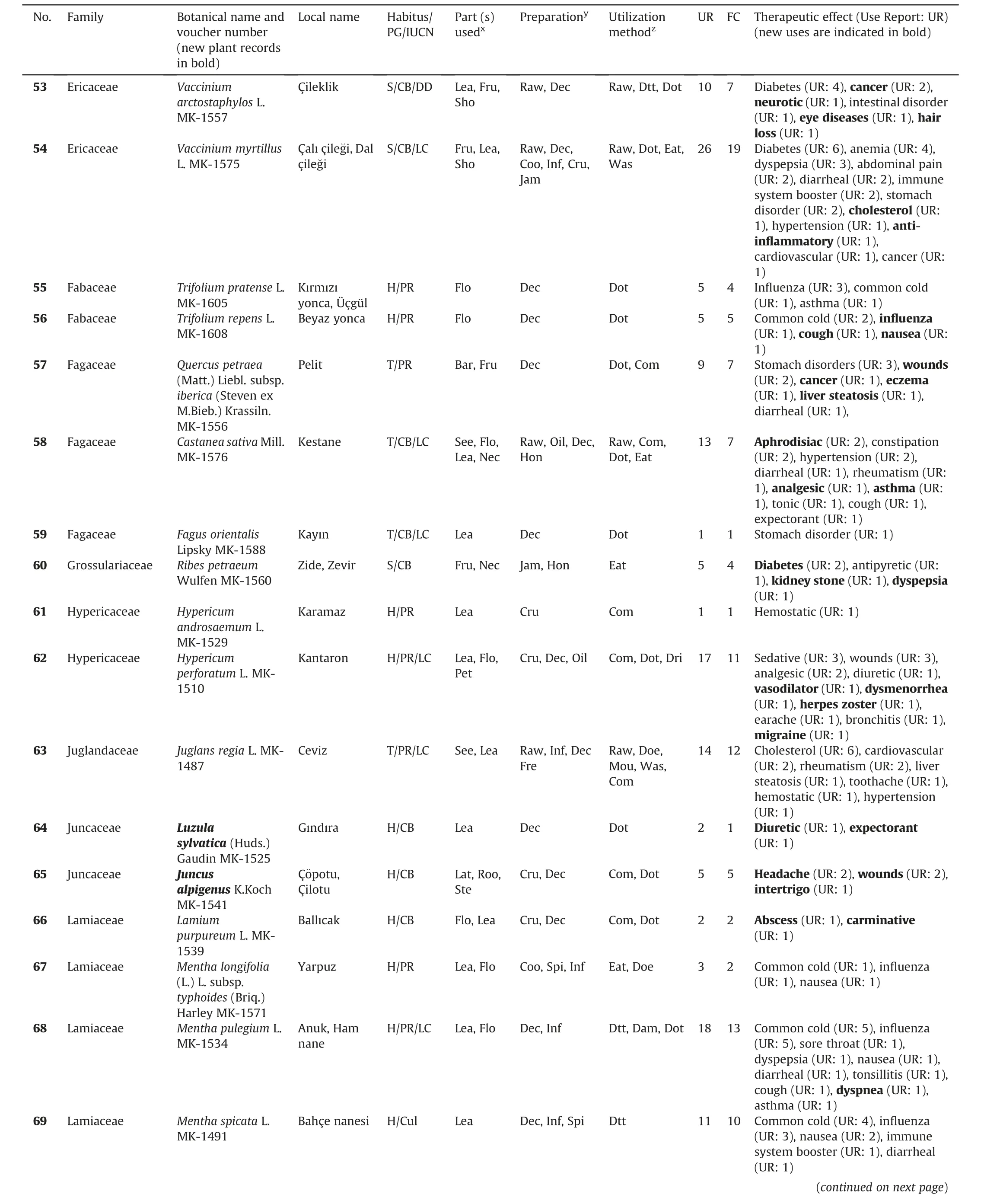
Table 2 (continued)
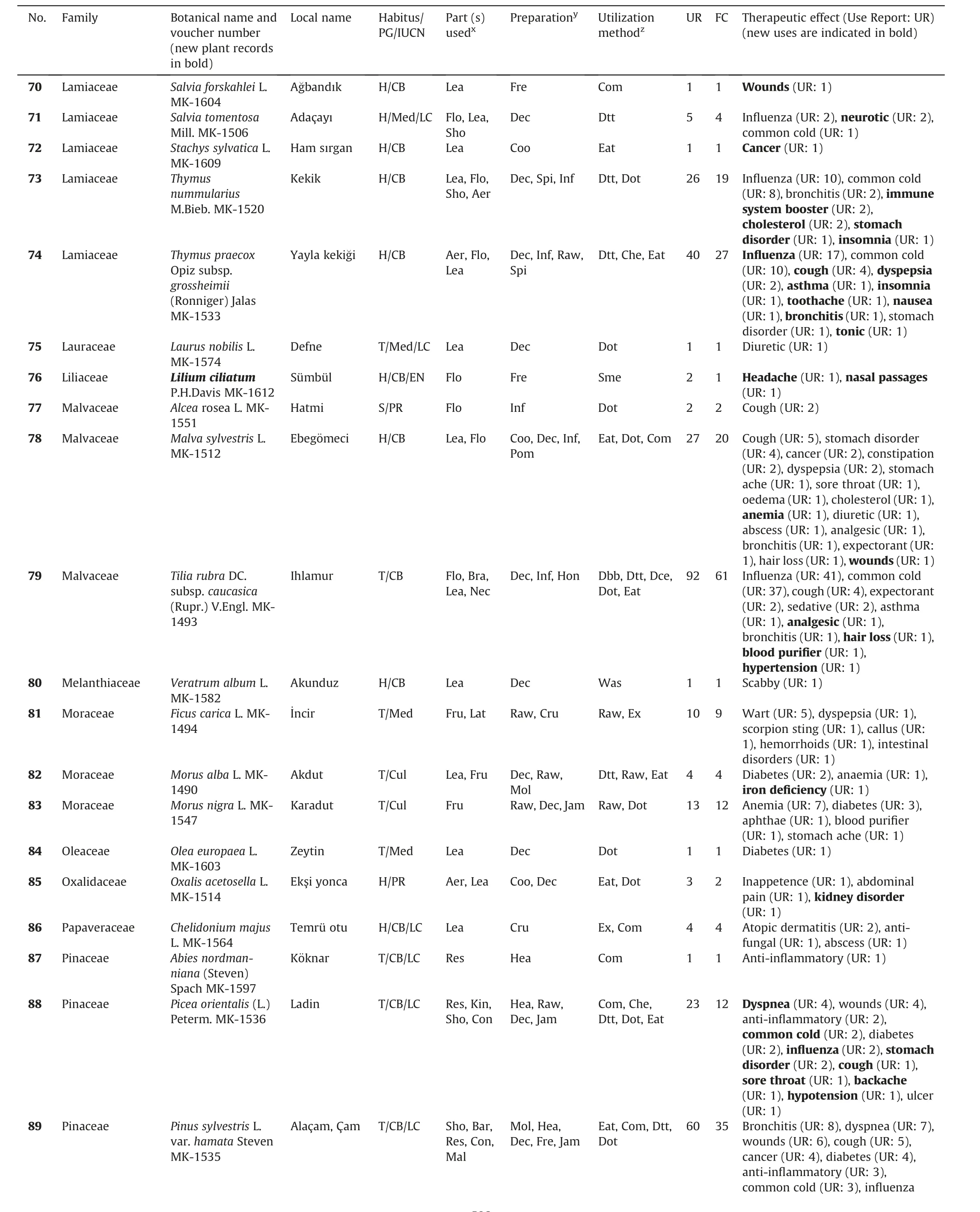
Table 2 (continued)
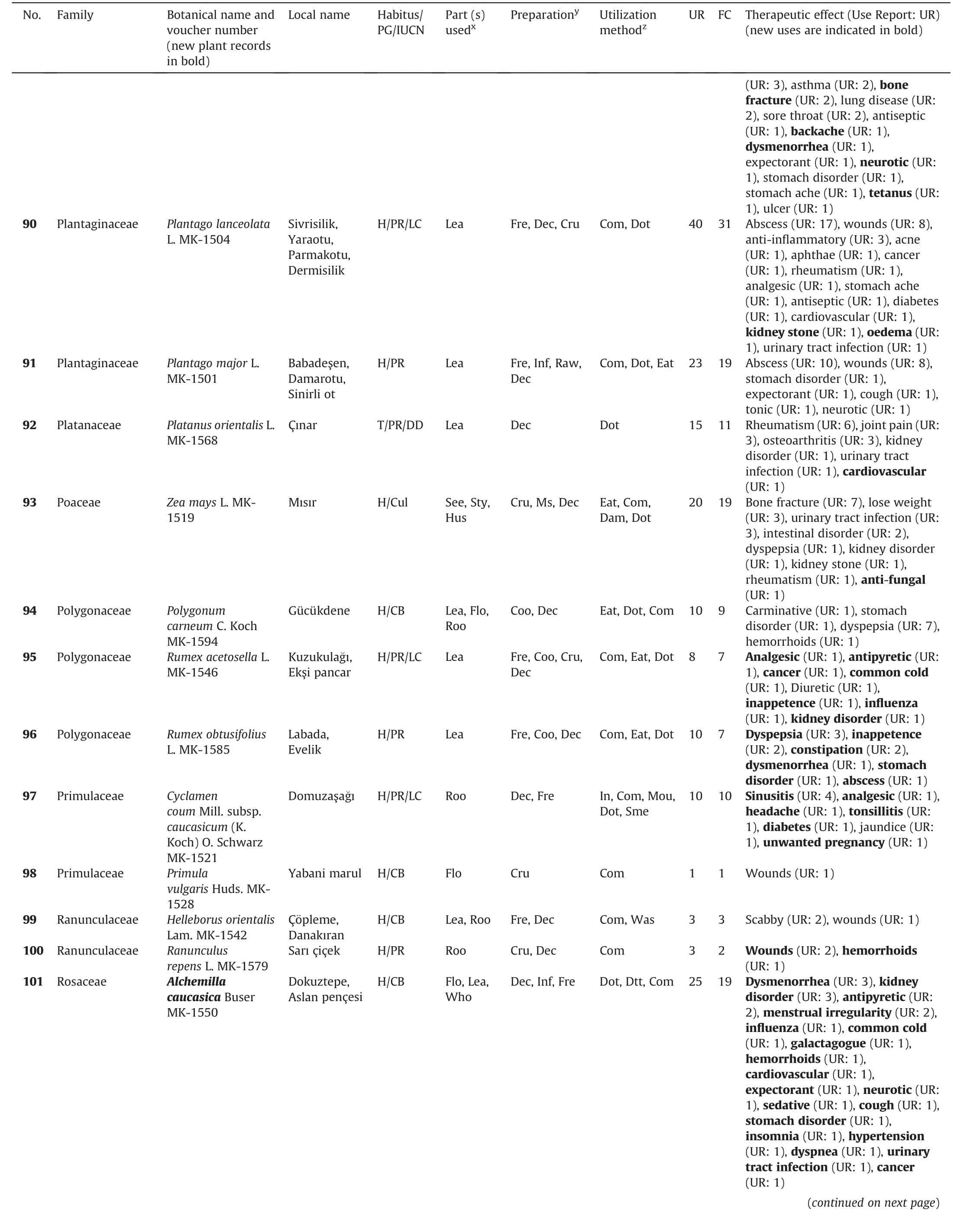
Table 2 (continued)
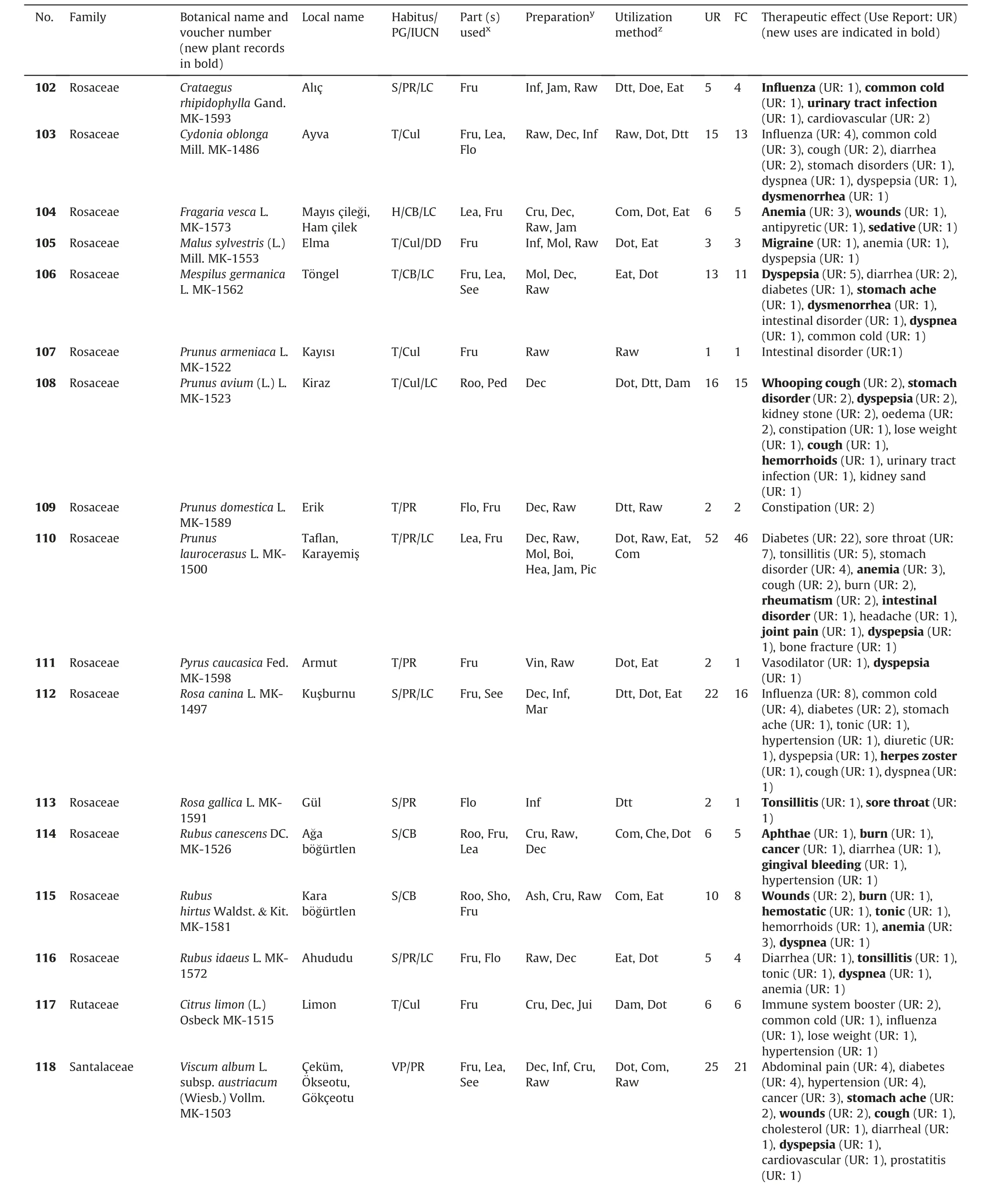
Table 2 (continued)

Table 2 (continued)
Local people collect some medicinal plants seasonally and sell them at restaurants,local bazaars,and markets to generate income.In Güce district, wild plants that generate income include Castanea sativa,Fragaria vesca L.,Helichrysum arenarium(L.)Moench subsp. aucheri (Boiss.) P.H. Davis & Kupicha, Mespilus germanica L.,Ornithogalum sigmoideum Freyn&Sint.,Prunus avium,P.laurocerasus L.,Pyrus caucasica Fed.,Rubus canescens DC.,R.hirtus Waldst.&Kit.,Thymus nummularius M. Bieb., T. praecox Opiz subsp. grossheimii(Ronniger)Jalas,Tilia rubra subsp.caucasica,Trachystemon orientalis(L.) D. Don, Urtica dioica, and Vaccinium myrtillus L. In addition to these, some plants such as Brassica oleracea L., Corylus avellana L.,Zea mays, Vitis vinifera L., and V. labrusca L. are cultivated both for personal use and as supplemental income. Turkey ranks second globally in honey production(Karak¨ose et al.,2018a).Unsurprisingly,honey production in Güce district is important. Both mono-floral and poly-floral honey types are produced. Mono-floral honeys,especially Castanea sativa and Rhododendron spp., are particularly popular. Furthermore, in Boncuk?ukur village of Güce, honey derived from Buxus sempervirens L.,Tilia rubra subsp.caucasica,and Hedera helix L. is produced. Chestnut honey is used as an expectorant,tonic,and aphrodisiac in the region.Other honey types(honey obtained from Rhododendron spp.is known as“mad honey”),on the other hand,are considered dangerous due to their active ingredients,but are consumed in small amounts to reduce blood pressure.
In ethnobotanical studies, information about gynecological diseases is sometimes difficult to obtain due to the hesitation or shyness of female informants, who consider talking about the diseases taboo (as women's diseases).In this study,extensive data on gynecological diseases were obtained due to the friendly atmosphere between the study team and the informants.A total of 21 plants are used to treat five gynecological disorders. Of these, the highest UR value was for dysmenorrhea (UR: 15), followed by menstrual irregularity (UR: 4), menopause, unwanted pregnancy,and postpartum pain (UR: 1 for each).
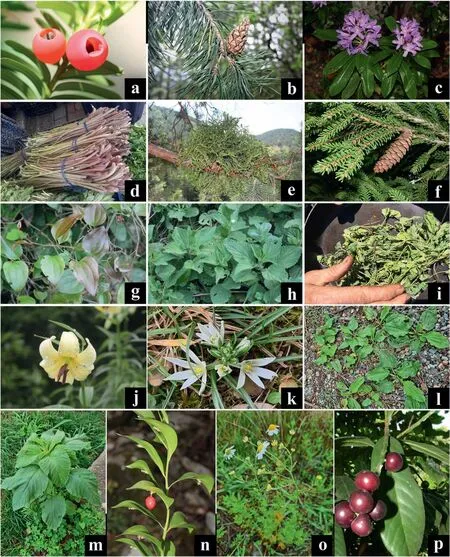
Fig.3. Representative medicinal plant species in this study.a:Taxus baccata L.;b:Pinus sylvestris var.hamata Steven;c:Rhododendron ponticum L.;d:Trachystemon orientalis(L.)D.Don;e:Viscum album L.subsp.austriacum(Wiesb.)Vollm.;f:Picea orientalis(L.)Peterm;g:Smilax excelsa L.;h:Urtica dioica L.;i:Malva sylvestris L.;j:Lilium ciliatum P.H.Davis;k:Ornithogalum sigmoideum Freyn & Sint.; l: Plantago major L.; m: Amaranthus retroflexus L.; n: Ruscus colchicus Yeo; o: Tripleurospermum elongatum (DC.) Bornm.; p: Prunus laurocerasus L.
During the research,some interesting usages by the local people were also identified. For instance, it was learned that the meal made with the fresh leaves of Aegopodium podagraria L. causes swelling in the hands of kidney patients; thus, local people guess that a person with swelling in their hands has kidney disease.The leaf of Sambucus ebulus L. is applied directly to affected areas to relieve irritation or allergy caused by Urtica dioica. Cyclamen coum Mill. subsp. caucasicum (K. Koch) O. Schwarz is applied directly to the genital area in the first month of pregnancy to abort an unwanted pregnancy.However,informants noted that this practice is dangerous. The green foam that is left after boiling Urtica dioica is used to treat cancer.
3.3. Preparation-utilization method and plant parts used
Data obtained from Güce district indicate that local people prepare medicinal plants using simple methods. Application of medicinal remedies can be grouped into five categories: oral(79.1%),topical(19.0%),wash(0.9%),inhale(0.8%),and eye-ear drop(0.2%).Medicinal remedies are prepared and utilized by a variety of methods (see Table 2). For example, medicinal remedies are prepared by decoction, cooking, pickling, as a honey, or directly applied. Utilization methods include chewing, drinking after a meal,eating,inhaling,and washing.The most frequently preferred methods for preparing folk medicines were decoction (40.2%),followed by cooking (10.4%), raw (10.1%), direct application (9.8%),and infusion(8.4%)(Fig.5).Similar results have been observed near the study area (Polat et al., 2015; Yes?ilyurt et al., 2017), at the national scale (Paksoy et al., 2016; Gunes, 2017; Günes? et al., 2017;Karc? et al.,2017),and in other countries(Gu et al.,2020; Hosseini et al.,2021).
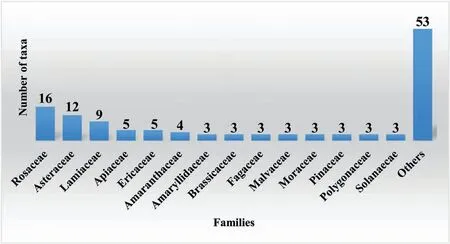
Fig. 4. Families of the most common medicinal plant species.
Local people use different plant parts for medicinal purposes.A total of 1246 URs were reported on plant parts. Folk medicines in Güce district are mainly prepared from leaves (502 URs/40.3%),followed by flowers(230 URs/18.5%),fruit(178 URs/14.3%),root(73 URs/5.9%), and seed (56 URs/4.5%) (Fig. 6). Several ethnobotanical studies have indicated that the leaf is the most frequent plant part used in folk medicine (Güler et al., 2015; Polat et al., 2015; Xiong et al., 2020; Mehrnia et al., 2021; Hosseini et al., 2021; Mir et al.,2021; Khajuria et al., 2021). The high usage frequency of leaves can be explained by the fact that they are easily collected, stored,densely presented, and supplied with various secondary metabolites.Usually,medicinal plants are seasonally used.However,some additional measures are taken to ensure that they are ready at hand in extraordinary situations. Local people have the opportunity to find the majority of medicinal plants in nature during the summer season.However,to benefit from these plants in other seasons,they dry some important medicinal plants. These herbs include
Thymus nummularius, T. praecox subsp. grossheimii, Tilia rubra subsp. caucasica, Alchemilla caucasica, Mentha spicata L., M. pulegium L., Urtica dioica, Malva sylvestris L., Polygonum carneum C.Koch, Prunus avium, Bellis perennis L., Tanacetum parthenium (L.)Sch. Bip., Tripleurospermum elongatum (DC.) Bornm.,Helichrysum arenarium subsp.aucheri,Platanus orientalis L.,Viscum album L. subsp. austriacum (Wiesb.) Vollm., Pteridium aquilinum,and Cydonia oblonga Mill.The parts of the dried plants that do not decay,such as leaves,flowers,and seeds,are preferred.During the winter months,fruits and stems are often converted into products(e.g.,vinegar,molasses,jam,pickles,and marmalade)for medicinal consumption.
3.4. Frequency of citation and use reports

Fig. 5. Preparation methods of herbal recipes.
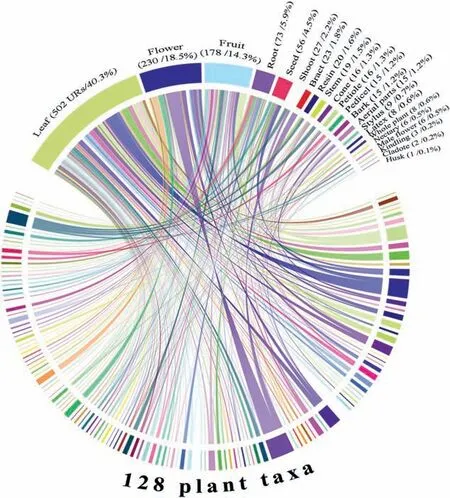
Fig. 6. Plant part usage rates.
Overall, male participants (111 plants) reported a greater number of medicinal plants than did female participants (105 plants),suggesting that males have more knowledge about the use of medicinal plants.This can be explained by the fact that the number of male participants was higher than that of females. However, analysis of FC indicates that individual female informants reported significantly greater numbers of medicinal plants than did male informants (df = 163, p = 0.037 < 0.05). Specifically, female informants cited an average of 7.48 plant names, whereas male informants reported an average of 5.65 (the mean use-value of the entire sample is 6.38).These findings indicate that females possess greater knowledge about medicinal plant uses. Similarly, TK according to UR is similar to the number of plant species given by informants. In the current study, a total of 1352 URs belonging to 128 plant taxa were mentioned by informants. Of the 1352 URs,52.8%(714 URs)were obtained from male and 47.2%(638 URs)from female informants. Statistical analysis indicated that when TK was considered as the number of plants cited, female informants possessed more knowledge (df = 163, p = 0.043 < 0.05). These results are consistent with previous studies(de Albuquerque et al.,2011;Gaoue et al.,2017).The FCs show the local importance of each plant taxon based on the informants who mentioned the usages of these plants (Hussain et al., 2019). The 165 informants from Güce district reported a total of 1052 FCs(Table 2).The most cited plant taxon was Tilia rubra subsp. caucasica (61). Tilia rubra subsp. caucasica is commonly used in the study area for influenza (UR: 41),common cold (UR: 37), cough (UR: 4), for expectorant purposes(UR: 2), as a sedative (UR: 2), for asthma (UR: 1), for analgesic purposes (UR: 1), for bronchitis (UR: 1), for hair loss (UR: 1), as a blood purifier(UR:1),and for hypertension(UR:1).The other most mentioned medicinal plant taxa in Güce district are Urtica dioica(53), Prunus laurocerasus (46), Pinus sylvestris var. hamata (35),Plantago lanceolata L. (31), and Thymus praecox subsp. grossheimii(27). The reason these plants have high FC values is that they are easily found in the study area and, therefore, easily collected.Tilia rubra subsp.caucasica had the highest number of UR(92 URs),followed by Urtica dioica and Pinus sylvestris var. hamata with 67 and 60 URs, respectively. This is the first study to calculate FC and UR values in Güce district.Therefore,these findings were compared to one ethnobotanical study conducted within the Colchic sector of the Circumboreal phytogeographical region in Turkey.UR values in the Güce district were similar to those calculated for areas close to the borders of two neighboring countries (Turkey and Georgia),where Plantago major L.ranked first (89 URs), Urtica dioica ranked second(54 URs),and Picea orientalis ranked third(43 URs)(Kazanc? et al., 2020). For the regions bordering Georgia with Turkey,Plantago major (with 65 URs) is again the most frequently cited,followed by Urtica dioica (with 62 URs) and Anthemis sp. (with 43 URs).
3.5. Informant consensus factor
When ICPC-2 classification was used to investigate consensus among informants on medicinal plant species, sixteen ailment categories were identified (Table 3). A total of 101 therapeutic effects were reported from Güce district.The main ailments,based on URs, were influenza (UR: 118), common cold (UR: 114), dyspepsia(UR: 95), wounds (UR: 69), diabetes (UR: 60), stomach disorder(UR:57),cough(UR:47),abscess(UR:43),cancer(UR:40),anemia(UR: 32), abdominal pain (UR: 27), rheumatism (UR: 27), dyspnea(UR: 22), cholesterol (UR: 20), headache (UR: 20), hypertension(UR: 20), bronchitis (UR: 19), cardiovascular diseases (UR: 19),hemorrhoids (UR: 19), and constipation (UR: 18). ICF of ailment categories in this study ranged from 0 to 0.86 (Table 3).
The highest ICF (0.86) value was calculated for respiratory system disorders (e.g., influenza, common cold, cough, dyspnea,bronchitis, sore throat, expectorant, tonsillitis, asthma, sinusitis,lung disease,whooping cough,and nasal passages).This result was expected for two reasons.Firstly,local people in the villages mostly make their living from animal husbandry,forestry,and agricultural activities. They migrate to the highlands with their animals to spend the summer months. During winter they return to their villages. Thus, in almost every season, they live in cold weather conditions and frequently encounter respiratory diseases such as influenza, common cold, bronchitis, and cough. A second reason may be related to air pollution (Palabas? Uzun and Koca, 2020). A report on air pollution in Turkey states that the air pollution level is 31% higher than that in Europe(UCTEA,2019). This raises the risk of contracting respiratory diseases. This study found that 55 plant taxa(with 375 URs)were used to treat different respiratory system disorders. The plant taxa most commonly reported for use in the treatment of respiratory system disorders are Tilia rubra subsp.caucasica (UR: 86), Thymus praecox subsp. grossheimii (UR: 33),Pinus sylvestris var.hamata(UR:33),Thymus nummularius(UR:20),Tripleurospermum elongatum (UR: 17), Bellis perennis (UR: 17),Mentha pulegium (UR: 15), Prunus laurocerasus (UR: 14), Rosa canina L. (UR: 14), Picea orientalis (UR: 10), and Cydonia oblonga(UR: 10). The second-highest ICF value (0.73) was calculated for digestive system disorders (e.g., dyspepsia, stomach disorder,abdominal pain, constipation, stomachache, carminative, diarrheal,intestinal disorders,nausea,intestinal worm,liver steatosis,toothache, aphthae, ulcer, mumps, hepatitis, gall bladder, and gingival bleeding). This finding is likely the result of local eating habits,which are typified by spicy,milky,and carbohydrate-heavy food(Yes?ilada et al.,1993;Dalar et al.,2018).The third highest ICF value (0.71) was calculated for skin (dermatological) disorders.This study identified 58 plant taxa (200 URs) used to treat dermatological disorders. Plant taxa cited as cures for skin diseases (e.g., wounds, abscesses, inflammation) included Plantago lanceolata (UR: 30), P. major (UR: 18), Alnus glutinosa subsp. barbata (UR: 11), and Pinus sylvestris var. hamata (UR: 10).Skin diseases and/or injuries are common in Güce district, where daily life is difficult and local people earn their livelihood under stressful working conditions (e.g., livestock, forestry, agriculture).These three groups are followed by muscle-skeletal disorders(ICF:0.65), blood, blood-forming organs and immune mechanism (ICF:0.62),endocrine/metabolic and nutritional(ICF:0.62),general and unspecified (ICF: 0.59), and cardiovascular diseases (ICF: 0.54).Consensus could not be achieved in some ailment categories(eye,pregnancy-childbearing-family planning,and male genital)due to the low number of informants;thus,ICF values were calculated as 0 (zero).
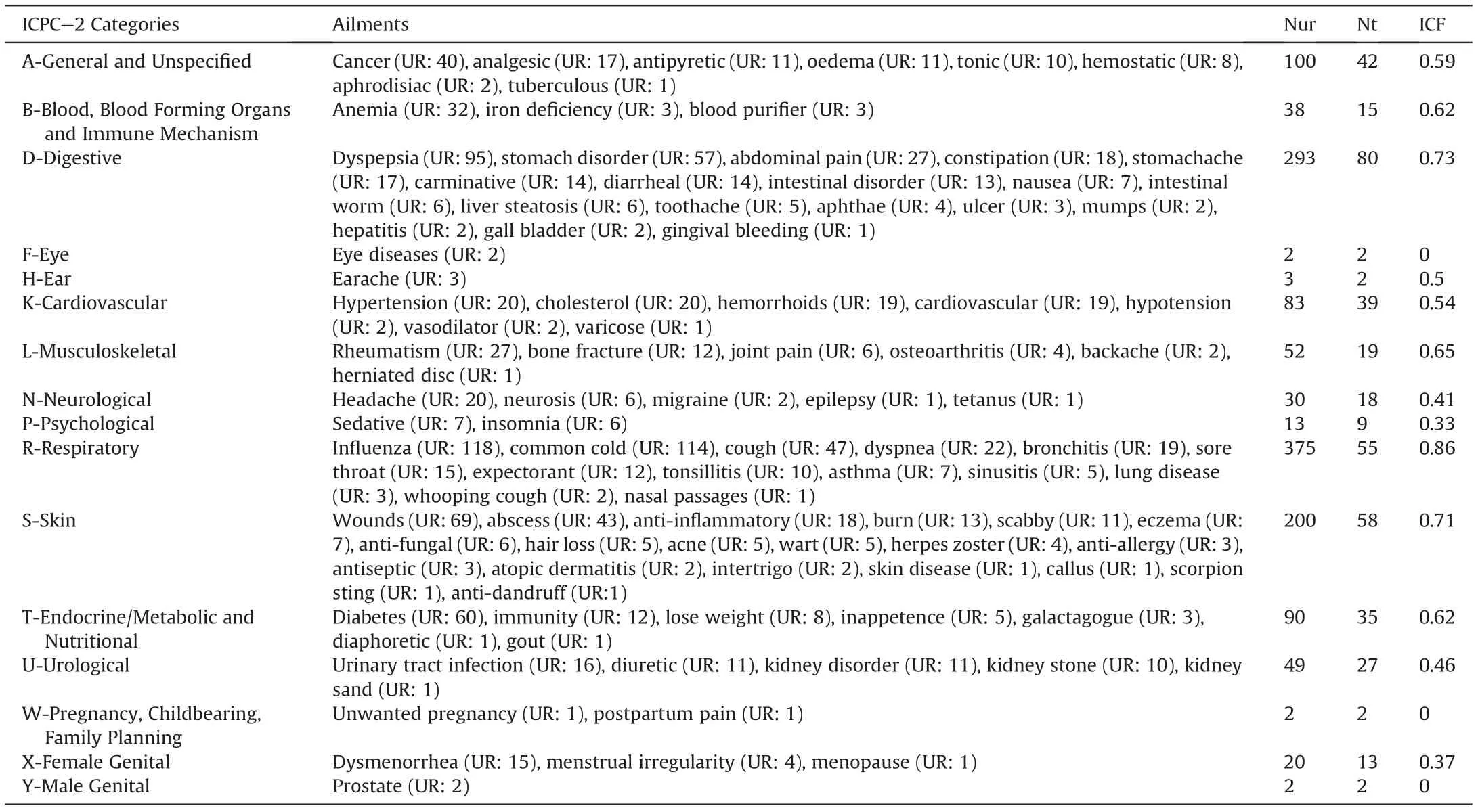
Table 3 ICF values for ICPC-2 ailment categories.
This is the first study to calculate ICF values in Güce. Previous studies have indicated that ICF values vary across the Black Sea region. For example, an ethnobotanical study conducted in a district neighboring Güce found the highest ICF for dermatological disorders (0.62), followed by gastrointestinal disorders (0.56)and respiratory tract problems (0.49) (Polat et al., 2015). In another neighboring district, the highest ICF value was calculated for “cold and flu”,followed by stomach disorders and gynecological diseases(Karak¨ose et al., 2019). In the Artvin province, located in Turkey's north-eastern Black Sea region, ICF values were not in accordance.Emina?gao?glu et al.(2017)found the highest ICF value for oncological disorders(0.55),followed by gastrointestinal(0.47)and respiratory(0.43) diseases. Bak and ?if?i (2020), however, reported that the highest ICF in the same region was“cold and flu”(0.87),followed by skin diseases (0.72) and urinary-intestinal disorders (ICF: 0.50 for each). In the north-western Black Sea region, the highest ICF value was calculated for skin diseases(0.75),followed by muscle-skeletal(0.74) and gastrointestinal disorders (0.66)(Gürbüz et al., 2019).In the central Black Sea region, the highest ICF value was determined for muscle-skeletal disorders (0.694), followed by respiratory(0.691) and dermatological system disorders (0.56) (Karc? et al.,2017). Another ethnobotanical study in the Black Sea region found that the highest ICF values were for the gynecological disorders and central nervous system disorders (1.00) (Yes?ilyurt et al., 2017). In Trabzon's Sürmene district, which neighbors Giresun province, the highest ICF value was calculated for anemia(0.89),followed by gynecological disorders (0.78) and insomnia (0.75) (Gürdal and¨Oztürk, 2021). These findings demonstrate that respiratory, digestive,and dermatological disorders are widespread in the study area and throughout the Black Sea region. These findings are also an indication that the traditional use of medicinal plants in the Black Sea region, which includes the town of Güce, continues. High ICF values can also be used in further studies to search for secondary metabolites of these medicinal plants.
3.6. Conservation status of medicinal plants
Plants are an important element of any ecosystem, and their protection is essential for the continuity of life. According to IUCN(Allen et al.,2014),almost half of the medicinal plants used on earth are under threat, and necessary precautions are needed for the survival of threatened plant species.For this purpose,plants in the priority conservation class in Turkey are under protection by national laws and some international regulations such as The Convention on Biological Diversity, Bern Convention (The Convention on the Conservation of European Wildlife and Natural Habitats), CITES (The Convention on International Trade in Endangered Species of Wild Fauna and Flora), etc. This study identified three endemic plants used for medicinal purposes, namely Lilium ciliatum P.H. Davis, Helichrysum arenarium subsp. aucheri,and Carduus onopordioides Fisch.ex M.Bieb.subsp.turcicus(Kazmi)P.H. Davis (Table 2). However, some medicinal taxa have been included in the “under-threat” categories by IUCN (https://www.iucnredlist.org/) due to the negative effects on population sizes resulting from the overuse by human beings on a regional or global scale. This study identified 43 medical taxa belonging to this category.Four medicinal taxa are categorized as Data Deficient(DD)and 39 taxa as Least Concern (LC). In addition to these taxa, this study identified two medicinal taxa (Cyclamen coum subsp. caucasicum and Vaccinium arctostaphylos L.) protected by the Bern Convention and one medicinal taxon (Cyclamen coum subsp. caucasicum) protected by CITES. However, these protected taxa are at risk due to anthropogenic factors such as field opening, illegal cutting, fire, livestock grazing, and inappropriate land use. These anthropogenic factors harm natural plant populations by damaging the habitats of the species, allowing alien species to settle and reproduce in the ecosystem(Karak¨ose et al.,2018b).In the eastern Black Sea region, where Güce is located, inappropriate land use is prevalent.For example,Alnus glutinosa forests are commonly clearcut to plant hazelnut orchards.These orchards, and other artificial areas (e.g., agriculture, roadsides etc.) create new ecosystems in which alien plants flourish (Karak¨ose et al., 2018b). Conservation efforts should be started urgently to protect medicinal species in such transformed areas in the Güce district.
3.7. Novelty and future prospects
When I compared the ethnomedicinal knowledge of Güce with that of surrounding regions,I found that nine of the 128 medicinal plant taxa recorded here had been previously recorded in northeastern Turkey and other countries located in the Circumboreal phytogeographical region (Table 2). These plant taxa are Alchemillacaucasica, Juncus alpigenus K. Koch, Lilium ciliatum, Luzula sylvatica (Huds.) Gaudin, Ornithogalum sigmoideum, Prenanthes petiolata(K.Koch)Sennikov,Ruscus colchicus Yeo,Taraxacum laxum G.E. Hagl., and Tripleurospermum elongatum. In addition to these,293 therapeutic usages of these plants were recorded for the first time (indicated in bold font in Table 2). For example, some of the newly documented usages include Equisetum telmateia Ehrh.(herniated disc), Arum maculatum L. (herpes zoster),Alchemilla caucasica (menstrual irregularity, dysmenorrhea), Crataegus rhipidophylla Gand. (urinary tract infection),Mespilus germanica (dysmenorrhea), Prunus avium (whooping cough), Vitis vinifera (toothache), Quercus petraea subsp. iberica(cancer,liver steatosis).These medicinal plant taxa and their usages should be further investigated to identify their active ingredients and pharmacological properties.
This study determined that the most common and popular medicinal plant taxa throughout the Circumboreal phytogeographical region are Achillea millefolium L.,Allium cepa L.,A.sativum L., Bellis perennis, Chelidonium majus L., Cornus mas L., Dioscorea communis (L.) Caddick & Wilkin, Ficus carica L., Hedera helix,Hypericum perforatum L.,Juglans regia L.,Mentha spicata,Morus alba L., M. nigra L., Pinus sylvestris var. hamata, Plantago lanceolata,P.major,Rosa canina,Sambucus ebulus,S.nigra L.,Tussilago farfara L.,Urtica dioica,Vaccinium myrtillus,and Zea mays(Vokou et al.,1993;Ivancheva and Stantcheva, 2000; Leporatti and Ivancheva, 2003,Pieroni et al., 2003, 2014a,b, 2015; Jari′c et al., 2007, 2015; Rigat et al., 2007; Leonti et al., 2009; Tita et al., 2009; Mustafa et al.,2012, 2020; Papp et al., 2013; Rexhepi et al., 2013; Bussmann et al., 2016a,b,2017a,b, 2018; S~oukand and Pieroni, 2016, 2019;Lumpert and Kreft, 2017; Pieroni, 2017; Jafarirad and Rasoulpour,2019; Savi′c et al., 2019; Varga et al., 2019; Mateji′c et al., 2020;Mattalia et al.,2020,2021;Sulaiman et al.,2020;ˇZuna Pfeiffer et al.,2020;?uczaj et al.,2021;Mullalija et al.,2021),are also commonly used in Güce and across Turkey (Sezik et al., 1991,1997, 2001;Yes?ilada et al., 1993, 1995, 1999; Tabata et al., 1994; Fujita et al.,1995; Yaz?c?o?glu and Tuzlac?, 1995; Honda et al., 1996; Tuzlac? and Erol, 1999; Tuzlac? and Tolon, 2000; Tuzlac? and Aymaz,2001; Yes?ilada, 2002; Everest and ¨Oztürk, 2005; Ezer and Ar?san,2006; Gen? and ¨Ozhatay, 2006; Ko?yi?git and ¨Ozhatay, 2006;Kültür,2007;Uysal et al.,2010;Gürdal and Kültür,2013;Bulut and Tuzlac?, 2013, 2015; Yes?ilyurt et al., 2017; Ayd?n and Yes?il, 2018;Gürbüz et al., 2019; Palabas? Uzun and Koca, 2020; Emre et al.,2021). The reason for the widespread use of these plant taxa is that they are cosmopolitan species and can easily be found in any habitat.
The medical usages identified in the study area were consistent with those of previous studies. For example, medicinal uses were similar across the region for Equisetum telmateia(stomach disorders),Asplenium scolopendrium L. (coughs), Arum maculatum L. (hemorrhoids), Dioscorea communis (L.) Caddick & Wilkin (rheumatism),Helleborus orientalis (wound healing), Buxus sempervirens (antipyretic), Cydonia oblonga (influenza, the common cold),Prunus laurocerasus (diabetes), Quercus petraea subsp. iberica (diarrhea), Plantago lanceolata (abscesses, wounds, inflammations), and Urtica dioica(cancer).
Güce district is located in the Colchic sector of the Euxine province within the Circumboreal phytogeographical region.When I compared plant usage data from Güce with that from previous studies of the Colchic sector (including Georgia), I found that medicinal plant usage in Güce was most similar to that in Espiye(Giresun) (Polat et al., 2015) and least similar to that in northeastern Anatolia (Sezik et al., 1991). These similarities are expected as Espiye is adjacent to Güce and shares the same ecosystems(Yes?il and ˙Inal,2021).One reason that Güce and north-eastern Anatolia show low similarity in plant usage may be related to the traditional data obtained from the areas belonging to the Irano-Turanian (outside the Circumboreal phytogeographical region)phytogeographical region.Medicinal plant usages are similar across the Turkish division of the Colchic sector.
Güce shares the use of 40 plant taxa with Espiye (Polat et al.,2015), 35 with Ordu (Türkan et al., 2006; Gül and Dinler, 2016;Ayd?n and Yes?il, 2018), 63 with Trabzon (Yaz?c?o?glu and Tuzlac?,1995; Akbulut and Bayramo?glu, 2014; Akbulut and ¨Ozkan, 2014;Gürdal and ¨Oztürk,2021),53 with Rize(Sa?g?ro?glu et al.,2012;Sara? et al., 2013; Baykal and Atamov, 2017), 12 with Torul (Karak¨ose et al., 2019), and 33 with Artvin (Emina?gao?glu et al., 2017; Bak and ?if?i, 2020). However, in the Turkish division of the Colchic sector, plants also have for different therapeutic usages. For example, in Hayrat, leaves of Rumex obtusifolius L. are used for the treatment of hemorrhoids (Sa?g?ro?glu et al., 2012); in Güce, leaves are used for the treatment of abscess,constipation,dysmenorrhea,dyspepsia, inappetence, and stomach disorder. In Hatila-Artvin,Cyclamen coum subsp. caucasicum is used for the treatment of jaundice (Emina?gao?glu et al., 2017); in Güce, it is used for the treatment of analgesic,diabetes,headache,sinusitis,tonsillitis,and unwanted pregnancy. Stachys sylvatica L. usage varies in different areas. In Espiye, its leaves are used for the treatment of cardiac disorders (Polat et al., 2015); in Sürmene-Trabzon, for dysuria(Gürdal and ¨Oztürk, 2021); and in Güce, for cancer. While leaves and flowers of the endemic Carduus onopordioides subsp. turcicus are recorded to be used as a blood purifier and for the treatment of dyspnea and intestinal disorders in Güce,in Torul-Gümüs?hane it is used for the treatment of hemorrhoids (Karak¨ose et al., 2019).
Although Georgia is also located in the Colchic sector, its medicinal plant usages showed little similarity to those of Güce district. One factor that may explain these differences is the distance between Georgia and Güce district. Other factors may include differences in sub-flora and socio-cultural society structures between the two countries(Faruque et al.,2018).In Güce,medicinal usages were detected for characteristic plant taxa belonging to the Colchic sector, such as Abies nordmanniana, Hedera colchica (K. Koch) K.Koch,Picea orientalis,Ruscus colchicus,and Rhododendron ponticum L. While Abies nordmanniana is used in the Turkish division of the Colchic sector for anti-inflammatory, antiseptic, expectorant,wound healing purposes and for the treatment of constipation(Baytop, 1999; Akbulut and ¨Ozkan, 2014), it is also used in the Georgian division for hemostatic and vulnerary purposes,as well as for the treatment of eczema, tuberculosis, and ulcer (Bussmann et al., 2016a, 2016b; Bussmann, 2017). While Picea orientalis is used to treat tuberculosis, ulcer, bronchitis, and wounds in the Turkish division (Yaz?c?o?glu and Tuzlac?, 1995; Akbulut and Bayramo?glu, 2014) and the Georgian division (Bussmann et al.,2016a,b, 2017b; Bussmann, 2017), in Güce, it is used to treat additional ailments (e.g., for the treatment of dyspnea, inflammation,common cold, diabetes, influenza, stomach disorder, cough, sore throat,backache,and hypotension).Hedera colchica is used both in Güce and in Georgia (Bussmann et al., 2018) for the treatment of burns. Similarly, Alnus glutinosa subsp. barbata is used as a wound healer in both Turkey and Georgia (Bussmann et al., 2018). Interestingly, while there are medicinal usages of Castanea sativa and Fagus orientalis in Turkey(Baytop,1999;Sara? et al.,2013),no such record has been found in Georgia(Bussmann et al.,2016a,b,2017a,b, 2018; Bussmann, 2017). As stated in many studies (de Albuquerque et al., 2011; Bulut et al., 2017; Gaoue et al., 2017;Pieroni, 2017; Hu et al., 2020; Bhat et al., 2021; Hosseini et al.,2021), due to technological advances and the decrease in rural population, the transfer of TK to younger generations has become very difficult in recent years.Therefore,it is of great importance to record and protect the TK of any area or community. ANOVA showed that TK differed between four age groups (F = 3.355,p = 0.020) and four education levels (F = 4.487, p = 0.005).Although there are modern health facilities in the center of Güce,old people, unlike younger people, are reluctant to visit those facilities.In addition,knowledge and the number of medicinal plants cited increases with age,among both male and female informants(de Albuquerque et al.,2011;Gaoue et al.,2017;Nguyen et al.,2020;Yes?il and ˙Inal, 2021). In Güce, illiterate informants have more ethnobotanical knowledge, likely because they live in harmony with nature.
4. Conclusions
This study is the first ethnobotanical study conducted in Güce and surrounding villages. Informants in Güce and its villages reported that 128 plant taxa are used to treat 101 different ailment categories. The most used plant taxa were Tilia rubra subsp. caucasica, Urtica dioica, Prunus laurocerasus, Pinus sylvestris var.hamata,Plantago lanceolata,and Thymus praecox subsp.grossheimii.The most common ailments treated by plant taxa were respiratory tract disorders, followed by digestive disorders and skin diseases.The therapeutic usages of nine of the identified plant taxa were recorded for the first time. One of the most important findings of the study is that local people in Güce possess great experience and knowledge of the medical usages of plant taxa,indicating that local people still benefit from nature.Nevertheless,there is the risk that future generations will not be able to benefit from this knowledge.This study identified 46 plant taxa,three of which are endemic,that are conservation priorities and two plant taxa protected by CITES and Bern conventions. Unless conservation measures are implemented soon,these taxa may be displaced by invasive plant species.This will result in the failure to provide ecosystem services from natural habitats. This study also showed TK is lost because traditions and customs are not recorded or transferred to younger generations. Ethnobotanical studies should be carried out in different areas of the world both for the conservation of TK and for the discovery of new drugs because natural plant biodiversity in any region provides rapid, cheap, and sufficient alternative resources for healthcare of local people.
Author contributions
M.K.: Visualization, Supervision, Methodology, Statistical analysis, Writing.
Declaration of competing interest
The author has no conflicts of interest to declare.
Acknowledgments
I want to express my special thanks to all the people of Güce,especially my student Mehmet Ali and his family,who participated in this ethnobotanical study and shared valuable knowledge. I would like to thank the Forest engineers G¨ozde ?olak Karak¨ose and Mustafa S?en, and also the foresters Gürsel Alemin, Yakup Y?lmaz,and Mehmet Ke?eci,for their logistic help supplying plant materials and contacting local people.
Appendix A. Supplementary data
Supplementary data to this article can be found online at https://doi.org/10.1016/j.pld.2022.03.005.
- 植物多樣性的其它文章
- Plastome characteristics and species identification of Chinese medicinal wintergreens (Gaultheria, Ericaceae)
- Molecular cytogenetic study on the plants of Elymus nutans with varying fertility on the Qinghai-Tibet Plateau
- Seedling survival after simulating grazing and drought for two species from the Pamirs, northwestern China
- Borana rangeland of southern Ethiopia: Estimating biomass production and carrying capacity using field and remote sensing data
- Does the critically endangered Rhododendron amesiae deserve top priority for conservation?
- Fertile Woodwardia from the middle Eocene of South China and its implications for palaeogeography and palaeoclimate

